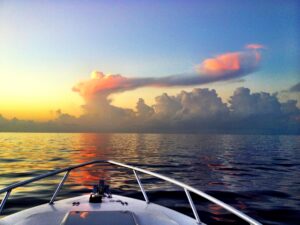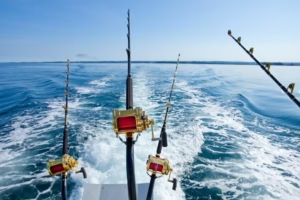Looking to check the current tides in your area?
If you want to operate a boat safely and effectively, you need to understand how the tide and currents work. Most people know that the tide is responsible for higher and lower levels of water, but they don’t fully understand the mechanics behind this phenomenon or how to navigate a changing tide. In this guide, we’ll teach you all the basics.
How Do Tides and Currents Work?
The rise and fall of tides are caused primarily by the moon. Though much smaller, the moon exerts 2.25 times the amount of gravitational pull on the oceans as does the sun. This is due to it being so much closer to Earth. When tides fall, the water goes from the poles to the equator. The spinning Earth creates centrifugal force that causes the water at the poles to be shallower and creates a bulge of water at the equator. Thus, there’s always a place for the water to go when the tides and currents change.
What Do Boaters Need to Know
Predicting Tides and Currents
Wherever in the world you boat, tides are predictable. High tides and low tides are predictable, and each one normally occurs twice daily at approximately six-hour intervals. As the time for high tide approaches, the sea water begins to flow toward shore, slowly at first, then with increasing speed (“current”) in the middle of the cycle, and then again with less speed toward the end of the cycle.
Once high tide is reached, the flow “in” stops, followed by “slack water.” Soon, the process starts in the opposite direction, and the flow “out” begins toward low tide. Again, the water begins to move slowly out to sea, with the current/speed of the flow increasing during the middle of the cycle, and the subsiding as the flow stops and the water reaches “slack water” (or “slack tide”).
The Rule of Twelfths
An important rule to keep in mind when studying the tides and currents is the The Rule of Twelfths. This is a rule of thumb allowing you to estimate the height of tide and the relative current flow for any area experiencing diurnal tides. It is expressed as a fraction of total volume per hour. All you need to know is the time of high or low tide. Starting from there, the tide will move in or out over the next six hours as follows: 1/12, 2/12, 3/12, 3/12, 2/12, 1/12.
Using the Rule of Twelfths can be important while cruising. For example, you can estimate when the most water will be flowing through an inlet — generally during the middle of a tide — which can cause the roughest conditions. Or in shoal areas, you can estimate how much water to expect beneath your keel at a given time.
Characteristics of Tides and Currents
Tide changes as per the 4 stages given below.
- Flood Tide – Over a period of several hours there will be a rise in sea level.
- High Tide – This is a stage where the water reaches its maximum level.
- Ebb Tide – This is a stage where sea level keeps receding over several hours.
- Low Tide – The Level of Seawater stops receding.
Why Do Boaters Need to Be Aware?
The changing tides and currents can cause several feet of change in the water depth (sea level), so it’s important boaters are aware of the tide’s direction (is it coming or going?) and timing whenever they are boating. Even if it seems like a minuscule level of water depth change, tides can affect things like:
- How much rope you need to tie onto a dock
- How much clearance you have to sail underneath a bridge
- Whether or not your boat bottoms out on a shoal where just a few hours ago the water was deep enough to cruise across
- Your ability or desire to cruise into a harbor where you might be moored, anchored, or docked for several hours at a time
- How long you can safely stay anchored somewhere. If you underestimate the tide, if the tide goes out, your yacht might just end up beached in place until the next tide rolls in. If the tide rolls in and your anchor isn’t fully dug into the seabed, your boat is likely going to drift.
- When you’ll be able to pass narrow channels. For certain channels, boaters need to plan their passages around the direction of the tidal flow. In some locales, it may be impossible to travel against the current.
The Perfect Boat for High or Low Tide
Give yourself the advantage of a reliable, luxurious boat by joining with Gulfstream Boat Club. Our fleet of boats are built to a higher standard, with superior materials and made with top-quality brands and gear you trust. We only choose the boats you would want to own yourself! Learn more about becoming a Member by contacting us today!


